AC&DC Ltd. Financial Accounting Assignment Solution
VerifiedAdded on 2021/08/10
|28
|3540
|239
Homework Assignment
AI Summary
This assignment presents a comprehensive financial accounting solution for AC&DC Ltd. It begins with an explanation of the accounting cycle, detailing the steps from transactions and journal entries to the creation of financial statements. The solution includes a detailed journal, T-accounts, and a trial balance, showcasing the application of accounting principles. The assignment covers various transactions, including material purchases, revenue, expenses, and depreciation, illustrating how these are recorded and summarized. It also provides calculations for depreciation using both the straight-line and double-declining balance methods. Furthermore, the solution constructs an income statement and a balance sheet, providing a clear overview of AC&DC Ltd.'s financial performance and position. The document serves as a valuable resource for understanding financial accounting practices and the preparation of key financial reports.

mo
bởi Mo Mo
Ngày Nộp: 10-thg 5-2021 03:07SA (UTC+0700)
ID Bài Nộp: 1582000496
Tên Tập tin: accounting.docx (109.63K)
Đếm từ: 3873
Đếm ký tự: 18971
bởi Mo Mo
Ngày Nộp: 10-thg 5-2021 03:07SA (UTC+0700)
ID Bài Nộp: 1582000496
Tên Tập tin: accounting.docx (109.63K)
Đếm từ: 3873
Đếm ký tự: 18971
Paraphrase This Document
Need a fresh take? Get an instant paraphrase of this document with our AI Paraphraser

1

ADst ract
The assignment is intended to use financial accounting methods to verify the financial
parameters of AC&DC Ltd as an accounting assistant. The accounting methods are
mainly used by preparing Journal, Ledger and Trial balance. The results are accurate
financial statements of AC&DC Ltd. Company.
The assignment is intended to use financial accounting methods to verify the financial
parameters of AC&DC Ltd as an accounting assistant. The accounting methods are
mainly used by preparing Journal, Ledger and Trial balance. The results are accurate
financial statements of AC&DC Ltd. Company.
⊘ This is a preview!⊘
Do you want full access?
Subscribe today to unlock all pages.

Trusted by 1+ million students worldwide
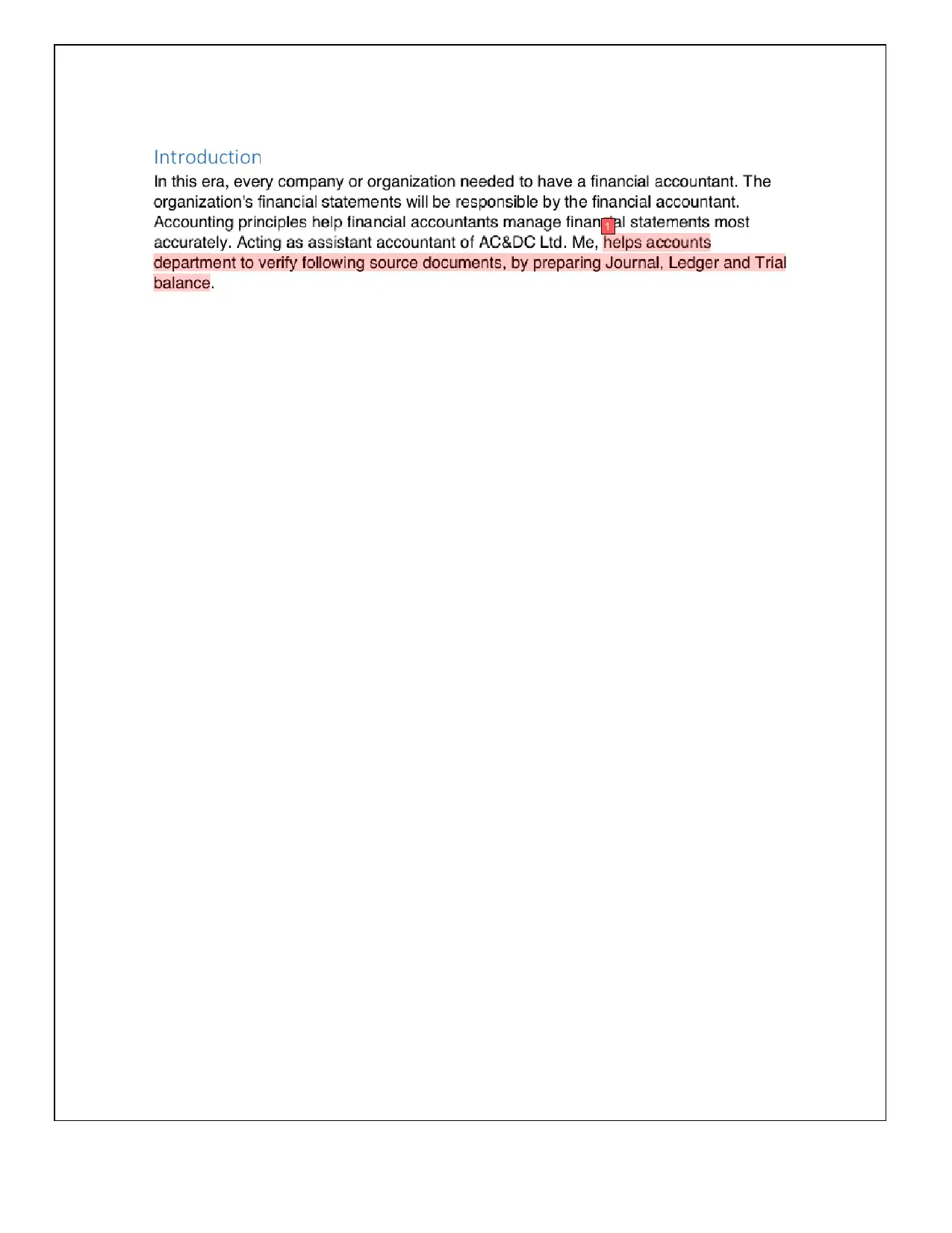
1
Paraphrase This Document
Need a fresh take? Get an instant paraphrase of this document with our AI Paraphraser
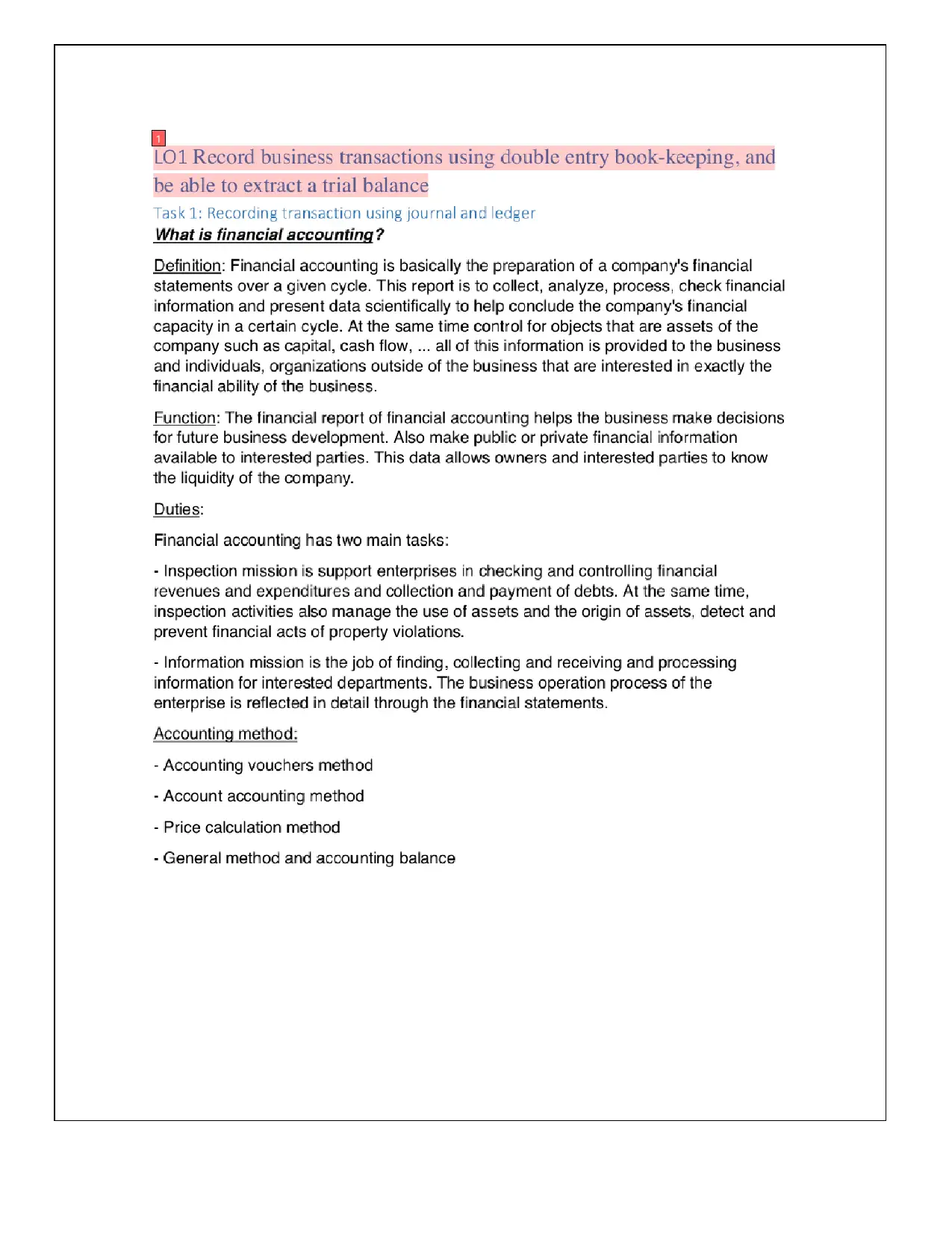
1
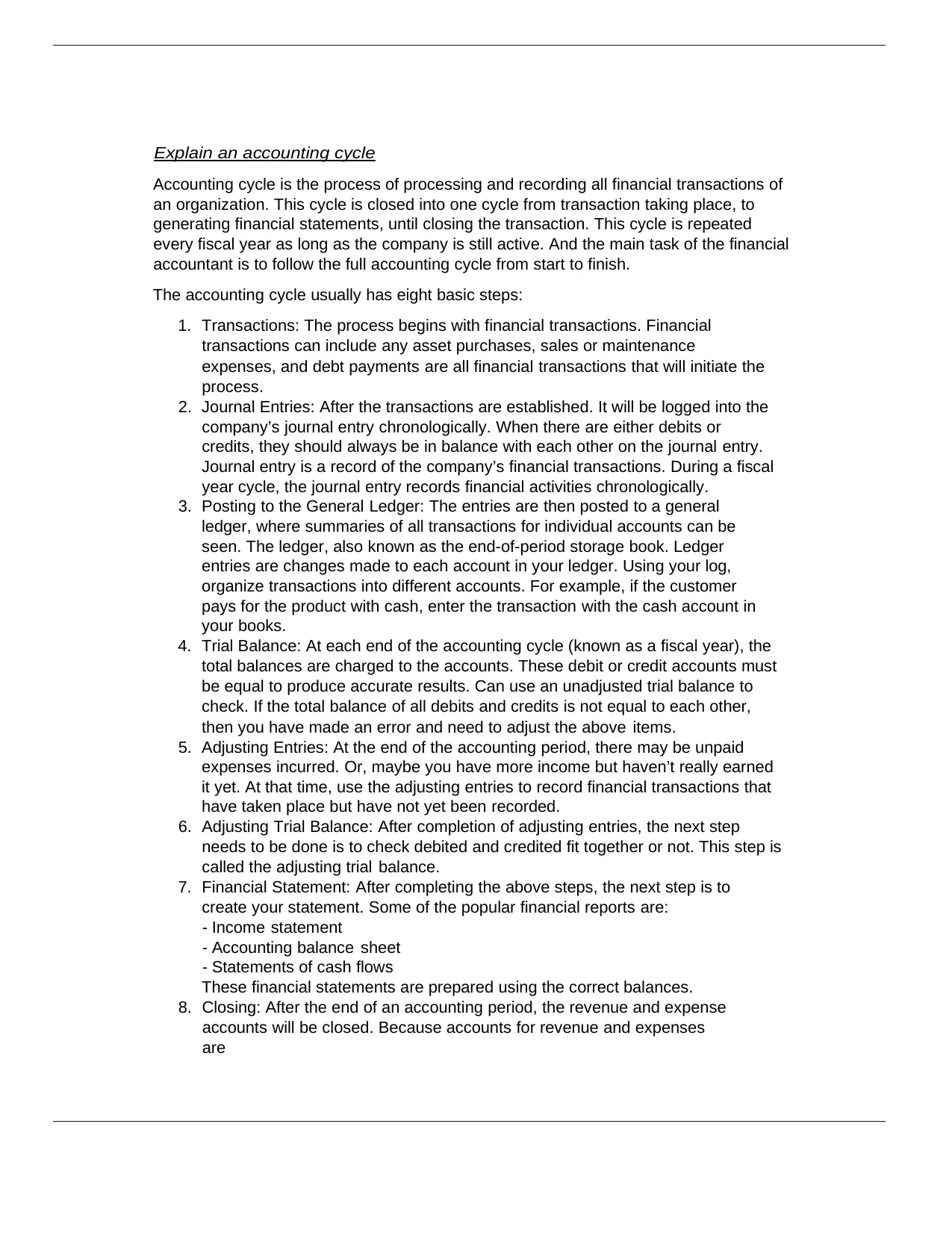
Explain an accounting cycle
Accounting cycle is the process of processing and recording all financial transactions of
an organization. This cycle is closed into one cycle from transaction taking place, to
generating financial statements, until closing the transaction. This cycle is repeated
every fiscal year as long as the company is still active. And the main task of the financial
accountant is to follow the full accounting cycle from start to finish.
The accounting cycle usually has eight basic steps:
1. Transactions: The process begins with financial transactions. Financial
transactions can include any asset purchases, sales or maintenance
expenses, and debt payments are all financial transactions that will initiate the
process.
2. Journal Entries: After the transactions are established. It will be logged into the
company’s journal entry chronologically. When there are either debits or
credits, they should always be in balance with each other on the journal entry.
Journal entry is a record of the company’s financial transactions. During a fiscal
year cycle, the journal entry records financial activities chronologically.
3. Posting to the General Ledger: The entries are then posted to a general
ledger, where summaries of all transactions for individual accounts can be
seen. The ledger, also known as the end-of-period storage book. Ledger
entries are changes made to each account in your ledger. Using your log,
organize transactions into different accounts. For example, if the customer
pays for the product with cash, enter the transaction with the cash account in
your books.
4. Trial Balance: At each end of the accounting cycle (known as a fiscal year), the
total balances are charged to the accounts. These debit or credit accounts must
be equal to produce accurate results. Can use an unadjusted trial balance to
check. If the total balance of all debits and credits is not equal to each other,
then you have made an error and need to adjust the above items.
5. Adjusting Entries: At the end of the accounting period, there may be unpaid
expenses incurred. Or, maybe you have more income but haven’t really earned
it yet. At that time, use the adjusting entries to record financial transactions that
have taken place but have not yet been recorded.
6. Adjusting Trial Balance: After completion of adjusting entries, the next step
needs to be done is to check debited and credited fit together or not. This step is
called the adjusting trial balance.
7. Financial Statement: After completing the above steps, the next step is to
create your statement. Some of the popular financial reports are:
- Income statement
- Accounting balance sheet
- Statements of cash flows
These financial statements are prepared using the correct balances.
8. Closing: After the end of an accounting period, the revenue and expense
accounts will be closed. Because accounts for revenue and expenses
are
Accounting cycle is the process of processing and recording all financial transactions of
an organization. This cycle is closed into one cycle from transaction taking place, to
generating financial statements, until closing the transaction. This cycle is repeated
every fiscal year as long as the company is still active. And the main task of the financial
accountant is to follow the full accounting cycle from start to finish.
The accounting cycle usually has eight basic steps:
1. Transactions: The process begins with financial transactions. Financial
transactions can include any asset purchases, sales or maintenance
expenses, and debt payments are all financial transactions that will initiate the
process.
2. Journal Entries: After the transactions are established. It will be logged into the
company’s journal entry chronologically. When there are either debits or
credits, they should always be in balance with each other on the journal entry.
Journal entry is a record of the company’s financial transactions. During a fiscal
year cycle, the journal entry records financial activities chronologically.
3. Posting to the General Ledger: The entries are then posted to a general
ledger, where summaries of all transactions for individual accounts can be
seen. The ledger, also known as the end-of-period storage book. Ledger
entries are changes made to each account in your ledger. Using your log,
organize transactions into different accounts. For example, if the customer
pays for the product with cash, enter the transaction with the cash account in
your books.
4. Trial Balance: At each end of the accounting cycle (known as a fiscal year), the
total balances are charged to the accounts. These debit or credit accounts must
be equal to produce accurate results. Can use an unadjusted trial balance to
check. If the total balance of all debits and credits is not equal to each other,
then you have made an error and need to adjust the above items.
5. Adjusting Entries: At the end of the accounting period, there may be unpaid
expenses incurred. Or, maybe you have more income but haven’t really earned
it yet. At that time, use the adjusting entries to record financial transactions that
have taken place but have not yet been recorded.
6. Adjusting Trial Balance: After completion of adjusting entries, the next step
needs to be done is to check debited and credited fit together or not. This step is
called the adjusting trial balance.
7. Financial Statement: After completing the above steps, the next step is to
create your statement. Some of the popular financial reports are:
- Income statement
- Accounting balance sheet
- Statements of cash flows
These financial statements are prepared using the correct balances.
8. Closing: After the end of an accounting period, the revenue and expense
accounts will be closed. Because accounts for revenue and expenses
are
⊘ This is a preview!⊘
Do you want full access?
Subscribe today to unlock all pages.

Trusted by 1+ million students worldwide
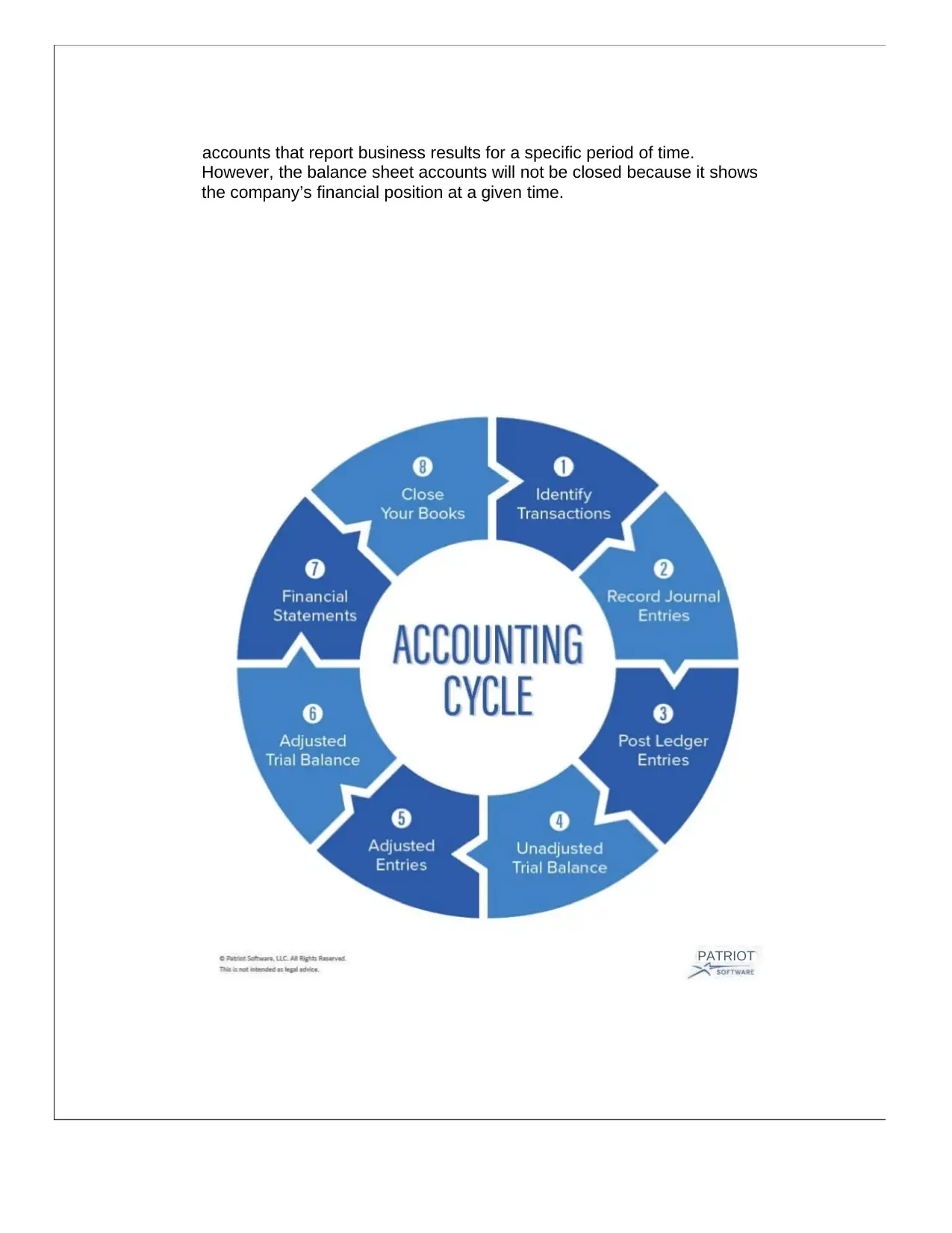
accounts that report business results for a specific period of time.
However, the balance sheet accounts will not be closed because it shows
the company’s financial position at a given time.
PATRIOT
However, the balance sheet accounts will not be closed because it shows
the company’s financial position at a given time.
PATRIOT
Paraphrase This Document
Need a fresh take? Get an instant paraphrase of this document with our AI Paraphraser
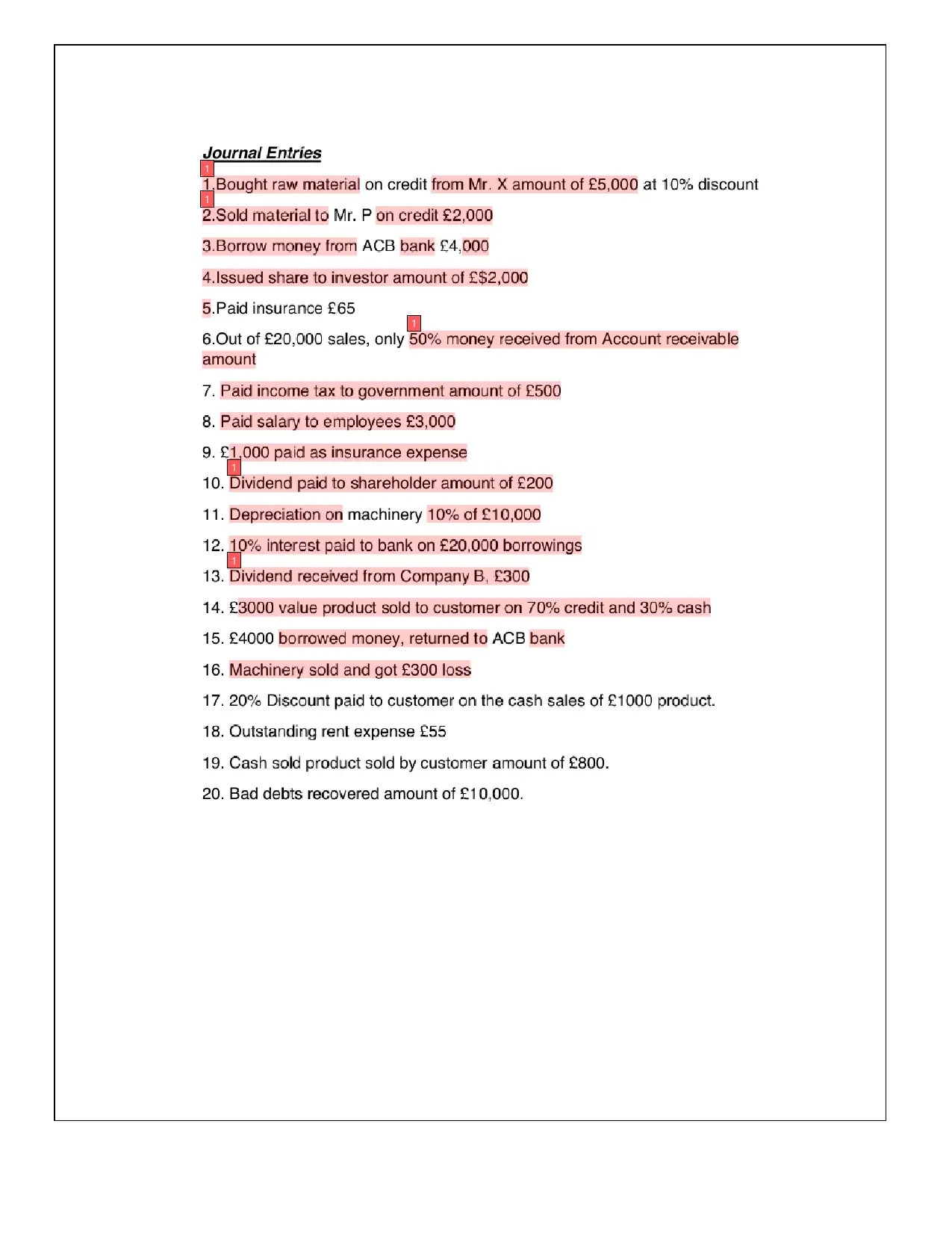
1
1
1
1
1
1
1
1
1
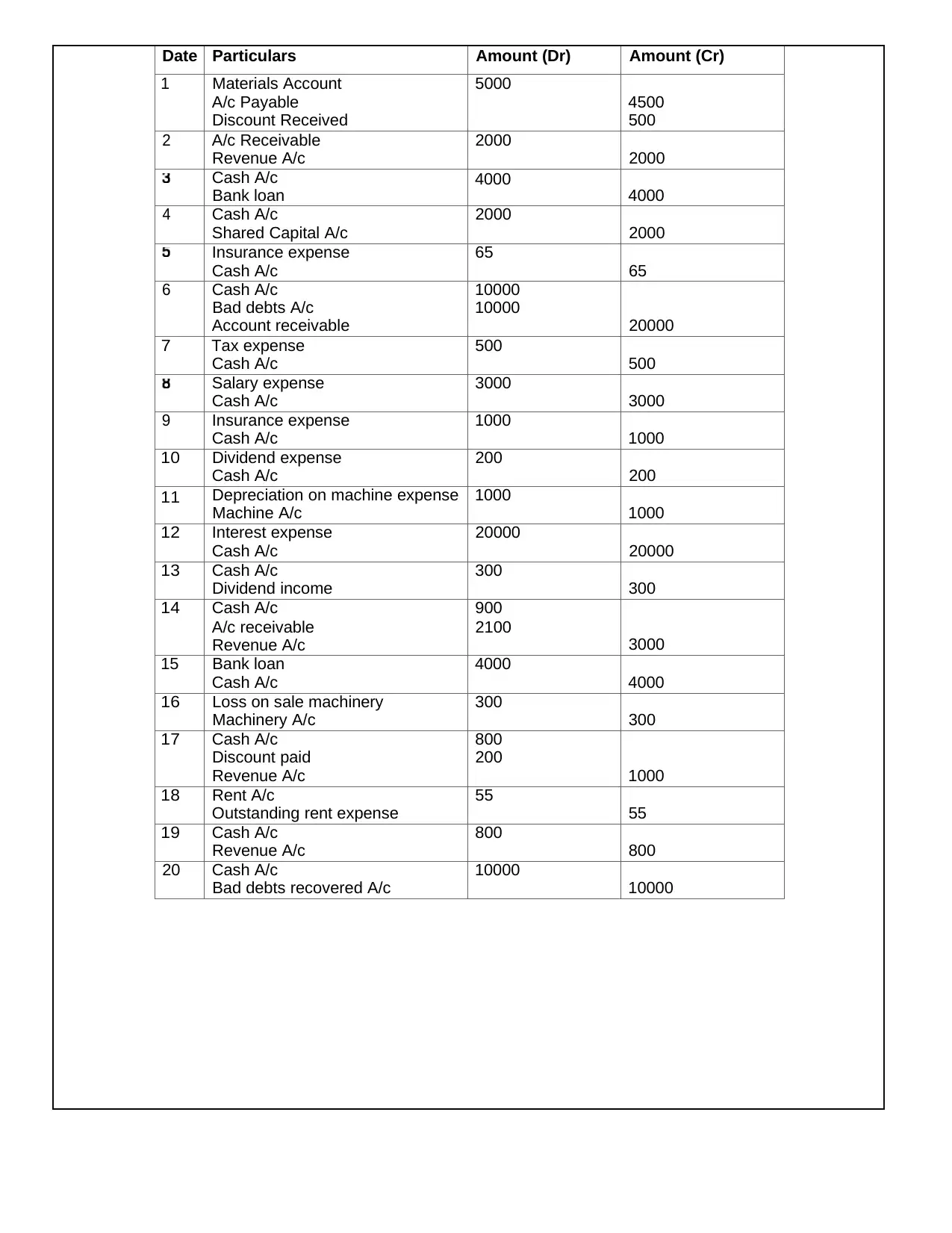
Date Particulars Amount (Dr) Amount (Cr)
1 Materials Account 5000
A/c Payable 4500
Discount Received 500
2 A/c Receivable 2000
Revenue A/c 2000
Cash A/c 4000
Bank loan 4000
4 Cash A/c 2000
Shared Capital A/c 2000
Insurance expense 65
Cash A/c 65
6 Cash A/c 10000
Bad debts A/c 10000
Account receivable 20000
7 Tax expense 500
Cash A/c 500
Salary expense 3000
Cash A/c 3000
9 Insurance expense 1000
Cash A/c 1000
10 Dividend expense 200
Cash A/c 200
11 Depreciation on machine expense 1000
Machine A/c 1000
12 Interest expense 20000
Cash A/c 20000
13 Cash A/c 300
Dividend income 300
14 Cash A/c 900
A/c receivable
Revenue A/c
2100
3000
15 Bank loan 4000
Cash A/c 4000
16 Loss on sale machinery 300
Machinery A/c 300
17 Cash A/c 800
Discount paid 200
Revenue A/c 1000
18 Rent A/c 55
Outstanding rent expense 55
19 Cash A/c 800
Revenue A/c 800
20 Cash A/c 10000
Bad debts recovered A/c 10000
1 Materials Account 5000
A/c Payable 4500
Discount Received 500
2 A/c Receivable 2000
Revenue A/c 2000
Cash A/c 4000
Bank loan 4000
4 Cash A/c 2000
Shared Capital A/c 2000
Insurance expense 65
Cash A/c 65
6 Cash A/c 10000
Bad debts A/c 10000
Account receivable 20000
7 Tax expense 500
Cash A/c 500
Salary expense 3000
Cash A/c 3000
9 Insurance expense 1000
Cash A/c 1000
10 Dividend expense 200
Cash A/c 200
11 Depreciation on machine expense 1000
Machine A/c 1000
12 Interest expense 20000
Cash A/c 20000
13 Cash A/c 300
Dividend income 300
14 Cash A/c 900
A/c receivable
Revenue A/c
2100
3000
15 Bank loan 4000
Cash A/c 4000
16 Loss on sale machinery 300
Machinery A/c 300
17 Cash A/c 800
Discount paid 200
Revenue A/c 1000
18 Rent A/c 55
Outstanding rent expense 55
19 Cash A/c 800
Revenue A/c 800
20 Cash A/c 10000
Bad debts recovered A/c 10000
⊘ This is a preview!⊘
Do you want full access?
Subscribe today to unlock all pages.

Trusted by 1+ million students worldwide

Doing T account
Cash account
(3) 4,000 (5) 65
(4) 2,000 (7) 500
(6) 10,000 (8) 3,000
(13) 300 (9) 1,000
(14) 900 (10) 200
(17) 800 (12) 2,000
(19) 800 (15) 4,000
(20) 10,000
28,800 | 10,765
8 0 5
For the Cash account, the debit is 28,800 and the credit is 10,765. Can see
a larger number of debit with credit (28,800 — 10,765 = 18,035).
Material urchased account
1 5,000
5,500 0
5 000
For Material account, the debit is 5,000 and the credit does not exist. Can see
a larger number of debit with credit (5,000 — 0 = 5,000).
Account a able
0 1
4,500
4,500
5400
For Account payable, the credit is 4,500 and the debit does not exist. Can see a
larger number of credit with debit (4,500 — 0 = 4,500).
Discount recieved
1 500
0 500
500
For Discount recieved, the credit is SOO and the debit does not exist. Can see a
larger number of credit with debit (500 — 0 = 500).
Cash account
(3) 4,000 (5) 65
(4) 2,000 (7) 500
(6) 10,000 (8) 3,000
(13) 300 (9) 1,000
(14) 900 (10) 200
(17) 800 (12) 2,000
(19) 800 (15) 4,000
(20) 10,000
28,800 | 10,765
8 0 5
For the Cash account, the debit is 28,800 and the credit is 10,765. Can see
a larger number of debit with credit (28,800 — 10,765 = 18,035).
Material urchased account
1 5,000
5,500 0
5 000
For Material account, the debit is 5,000 and the credit does not exist. Can see
a larger number of debit with credit (5,000 — 0 = 5,000).
Account a able
0 1
4,500
4,500
5400
For Account payable, the credit is 4,500 and the debit does not exist. Can see a
larger number of credit with debit (4,500 — 0 = 4,500).
Discount recieved
1 500
0 500
500
For Discount recieved, the credit is SOO and the debit does not exist. Can see a
larger number of credit with debit (500 — 0 = 500).
Paraphrase This Document
Need a fresh take? Get an instant paraphrase of this document with our AI Paraphraser
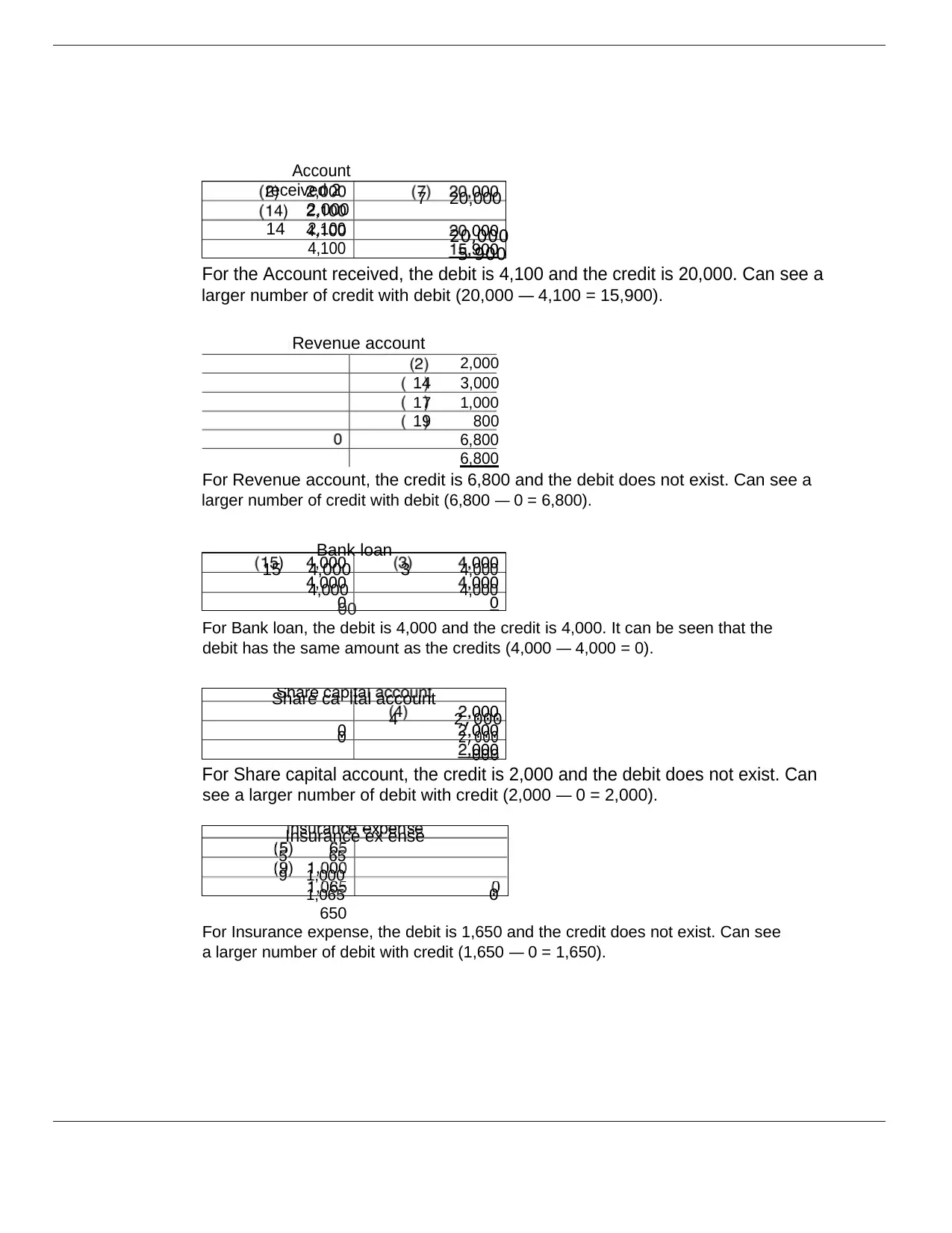
Account
received 2
2,000
14 2,100
4,100
7 20,000
20,000
5 900
For the Account received, the debit is 4,100 and the credit is 20,000. Can see a
larger number of credit with debit (20,000 — 4,100 = 15,900).
Revenue account
2,000
14 3,000
17 1,000
19 800
6,800
6,800
For Revenue account, the credit is 6,800 and the debit does not exist. Can see a
larger number of credit with debit (6,800 — 0 = 6,800).
Bank loan
15 4,000 3 4,000
4,000 4,000
00
For Bank loan, the debit is 4,000 and the credit is 4,000. It can be seen that the
debit has the same amount as the credits (4,000 — 4,000 = 0).
Share ca ital account
4 2,000
0 2,000
000
For Share capital account, the credit is 2,000 and the debit does not exist. Can
see a larger number of debit with credit (2,000 — 0 = 2,000).
Insurance ex ense
5 65
9 1,000
1,065 0
650
For Insurance expense, the debit is 1,650 and the credit does not exist. Can see
a larger number of debit with credit (1,650 — 0 = 1,650).
received 2
2,000
14 2,100
4,100
7 20,000
20,000
5 900
For the Account received, the debit is 4,100 and the credit is 20,000. Can see a
larger number of credit with debit (20,000 — 4,100 = 15,900).
Revenue account
2,000
14 3,000
17 1,000
19 800
6,800
6,800
For Revenue account, the credit is 6,800 and the debit does not exist. Can see a
larger number of credit with debit (6,800 — 0 = 6,800).
Bank loan
15 4,000 3 4,000
4,000 4,000
00
For Bank loan, the debit is 4,000 and the credit is 4,000. It can be seen that the
debit has the same amount as the credits (4,000 — 4,000 = 0).
Share ca ital account
4 2,000
0 2,000
000
For Share capital account, the credit is 2,000 and the debit does not exist. Can
see a larger number of debit with credit (2,000 — 0 = 2,000).
Insurance ex ense
5 65
9 1,000
1,065 0
650
For Insurance expense, the debit is 1,650 and the credit does not exist. Can see
a larger number of debit with credit (1,650 — 0 = 1,650).
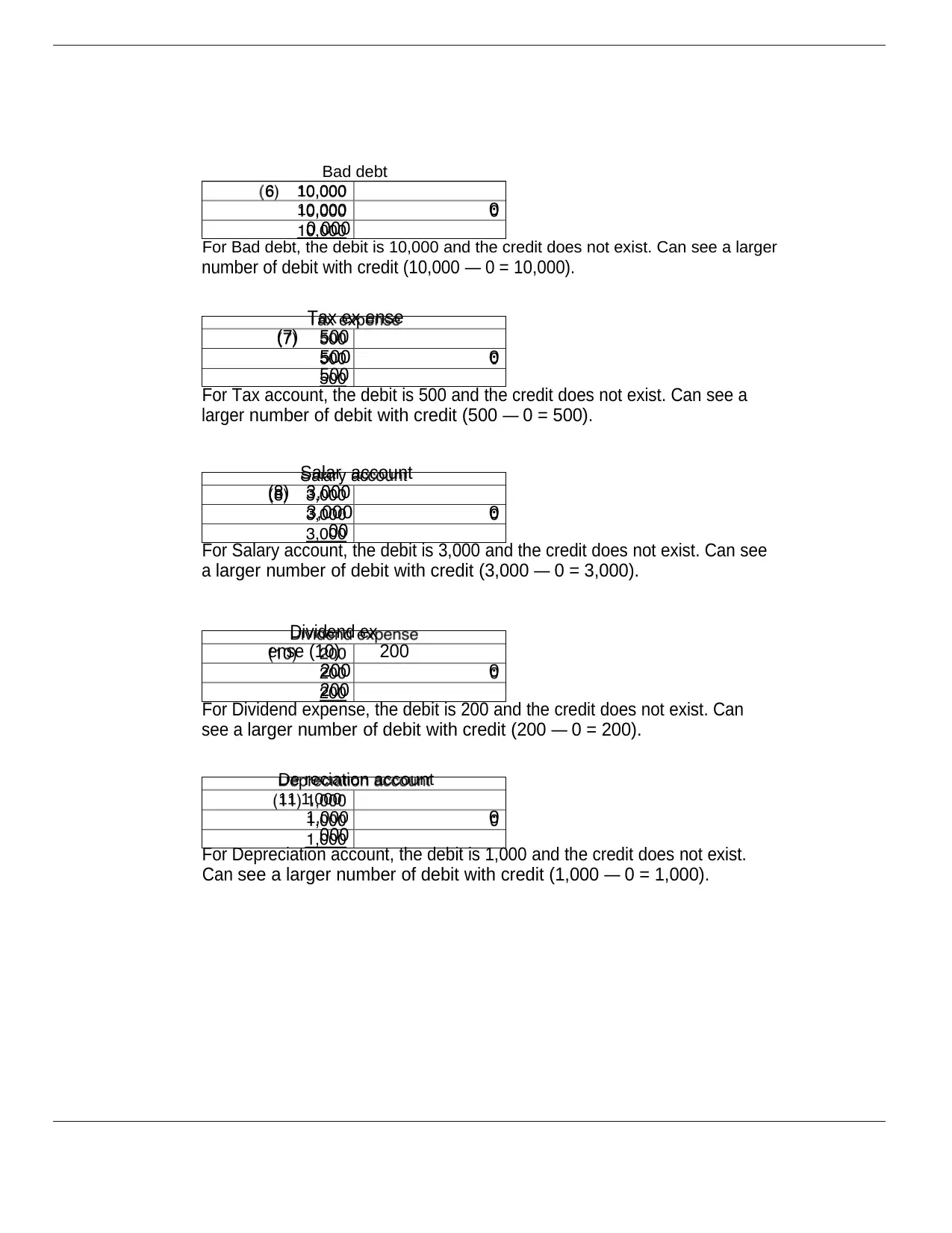
Bad debt
6 10,000
10,000 0
0 000
For Bad debt, the debit is 10,000 and the credit does not exist. Can see a larger
number of debit with credit (10,000 — 0 = 10,000).
Tax ex ense
(7) 500
500 0
500
For Tax account, the debit is 500 and the credit does not exist. Can see a
larger number of debit with credit (500 — 0 = 500).
Salar account
(8) 3,000
3,000 0
00
For Salary account, the debit is 3,000 and the credit does not exist. Can see
a larger number of debit with credit (3,000 — 0 = 3,000).
Dividend ex
ense (10) 200
200 0
200
For Dividend expense, the debit is 200 and the credit does not exist. Can
see a larger number of debit with credit (200 — 0 = 200).
De reciation account
11 1,000
1,000 0
000
For Depreciation account, the debit is 1,000 and the credit does not exist.
Can see a larger number of debit with credit (1,000 — 0 = 1,000).
6 10,000
10,000 0
0 000
For Bad debt, the debit is 10,000 and the credit does not exist. Can see a larger
number of debit with credit (10,000 — 0 = 10,000).
Tax ex ense
(7) 500
500 0
500
For Tax account, the debit is 500 and the credit does not exist. Can see a
larger number of debit with credit (500 — 0 = 500).
Salar account
(8) 3,000
3,000 0
00
For Salary account, the debit is 3,000 and the credit does not exist. Can see
a larger number of debit with credit (3,000 — 0 = 3,000).
Dividend ex
ense (10) 200
200 0
200
For Dividend expense, the debit is 200 and the credit does not exist. Can
see a larger number of debit with credit (200 — 0 = 200).
De reciation account
11 1,000
1,000 0
000
For Depreciation account, the debit is 1,000 and the credit does not exist.
Can see a larger number of debit with credit (1,000 — 0 = 1,000).
⊘ This is a preview!⊘
Do you want full access?
Subscribe today to unlock all pages.

Trusted by 1+ million students worldwide
1 out of 28
Related Documents
Your All-in-One AI-Powered Toolkit for Academic Success.
+13062052269
info@desklib.com
Available 24*7 on WhatsApp / Email
![[object Object]](/_next/static/media/star-bottom.7253800d.svg)
Unlock your academic potential
Copyright © 2020–2025 A2Z Services. All Rights Reserved. Developed and managed by ZUCOL.





